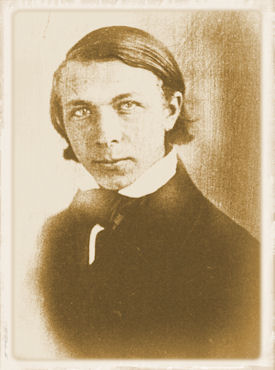

edited by Alois Payer
Cite as:
Kittel, F. (Ferdinand) <1832 - 1903>: A grammar of the Kannaḍa language in English : comprising the three dialects of the language (ancient, mediæval and modern). -- 1903. -- 0. Preface. -- Fassung vom 2009-12-13. -- URL: http://www.payer.de/kittel/kittel00.htm
Originally published as:
Kittel, F. (Ferdinand) <1832 - 1903>: A grammar of the Kannaḍa language in English : comprising the three dialects of the language (ancient, mediæval and modern). -- Mangalore : Basel Mission Book and Tract Depository, 1903. -- VI, 483 S. ; 24 cm.
The original edition is online available at: http://www.archive.org/details/grammarofKannaḍa00kittuoft. -- Accessed on 2009-12-12
First time published here: 2009-12-13
Revisions:
©opyright: Public domain
This text is part of the department Sanskrit ofTüpfli's Global Village Library
You need a font with diacritica as e.g. Tahoma
Kannaḍa-letters are coded in Unicode. You need a Unicode Kannaḍa font.
Use of brackets:
[] = additions by Alois Payer
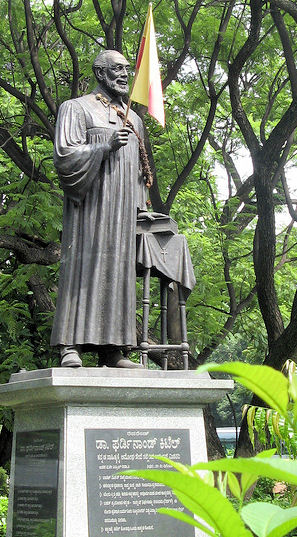
Abb.: Ferdinand Kittel monument, Bangalore (ಬೆಂಗಳೂರು)
[Neha & Lunatech. --
http://www.flickr.com/photos/53823243@N00/660136363. -- Accessed on
2009-12-12. --
Creative Commons License (by, share alike)]
"Reverend Ferdinand Kittel (Kannaḍa: ಫರ್ಡಿನ್ಯಾಂಡ್ ಕಿಟ್ಟೆಲ್) (7 April 1832 in Resterhafe, East Frisia – 18 December 1903 in Tübingen) was a priest and indologist with the Basel Mission in south India and worked in Mangalore [ಮಂಗಳೂರು], Madikeri [ಮಡಿಕೇರಿ] and Dharwad [ಧಾರವಾಡ] in Karnataka [ಕರ್ನಾಟಕ]. He is most famous for his studies of the Kannaḍa [ಕನ್ನಡ] language and for producing the first ever Kannaḍa-English dictionary of about 70,000 words in 1894. He also composed numerous Kannaḍa poems. He arrived in India in 1853. As a missionary, he endeavoured to follow Paul's first Epistle to the Corinthians and "become as an Indian unto the Indians", and undertook exhaustive studies learning the Kannaḍa language, customs and local music. This earned rebuke from the Basel Mission, where he was already an outsider on account of his North German origin and academic education (the other missionaries were chiefly from southwest Germany and the lower/middle classes), which marginalised him by pushing him to a remote station in the Nilgiris [ನೀಲಗಿರಿ] and later confining him to the mission's press in Mangalore. He returned to Germany, but visited India again in his fifties to complete his dictionary, which by then had become for him an end in itself, and not merely an instrument secondary to missionary work.
Reverend Ferdinand Kittel also wrote a book on Kannaḍa grammar called "A Grammar of the Kannaḍa Language: Comprising the Three Dialects of the language". He translated Nagavarma's work on Kannaḍa prosody.
He is today almost forgotten in Germany, but widely recognised in Karnataka. He is credited with shaping the Kannaḍa language and the regional identity of Kannaḍa speakers. Many educational institutions have been named after him. A statue at the end of Mahatma Gandhi road in the city of Bangalore [ಬೆಂಗಳೂರು] commemorates him. Austin Town in Bangalore was renamed "F Kittel Nagar".
The book An Indian to the Indians? On the Initial Failure and the Posthumous Success of the Missionary Ferdinand Kittel (1832–1903), edited by Reinhard Wendt, describes various aspects of his work."
[http://en.wikipedia.org/wiki/Ferdinand_Kittel. -- Accessed on 2009-12-12]

Fig.: Title page of: Kittel, F.
(Ferdinand) <1832 - 1903>: Kannada-English dictionary. --
Mangalore : Vasel Book & Tract Depository, 1894. -- 1752 p. -- Indispensable.
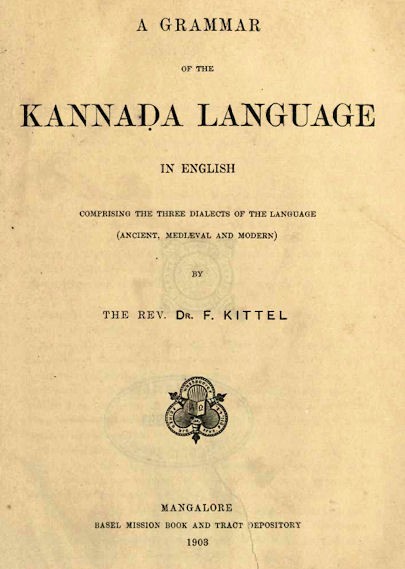
Fig.: Title page
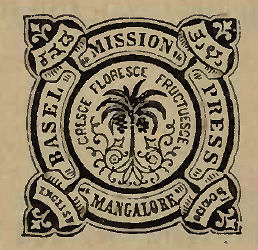
Fig.: Logo of the Basel Mission Press
The present Grammar is chiefly based on Kēśava's Śabdamaṇidarpaṇa. The terminology of this his Grammar is simple, and fit for the three dialects of Kannaḍa. At the same time it will be interesting to learn the general way of an ancient native scholar's teaching Kannaḍa grammar.
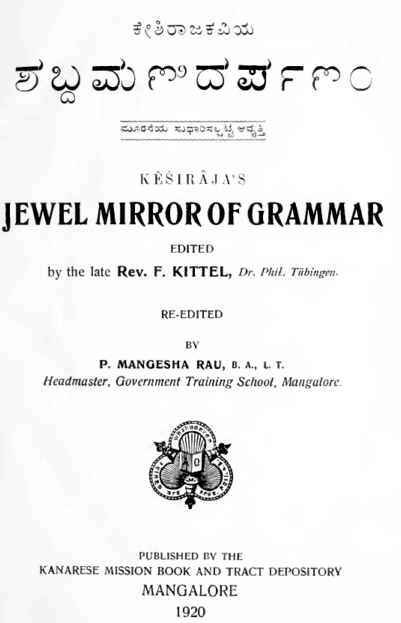
Fig.: Title page of: Kēśirāja <fl. 1260>: Śabdamaṇidarpaṇa / edited by
Ferdinand Kittel ; re-edited by P. Mangesha Rao. -- Mangalore : Kannarese
Mission Book and Tract Depository, 1920. -- 470 p. -- Online:
http://www.archive.org/details/abdamaidarpaa00kirjuoft. -- Accessed on
2009-12-13
In Kēśava's age most of the rules of Kannaḍa grammar were fixed. That before him there had been grammarians who had not deserved that name, seems to follow from his quoting a part of a Kanda verse that is fully quoted in the Śabdānuśāsana (under its sūtra 469), from which we translate it as follows
"Remain, daughter! Could the unprofitable grammarian (śuṣkavaiyākaraṇa), the unprofitable sophist and the rustic have as (their) subject matter the gem of poetical composition which is the subject matter of the assemblage of very clever poets?"
Some specific statements of Kēśava concerning his predecessors or contemporaries are the following --
He considered it a
matter of necessity to caution literary writers against using final ḷ in
several Kannaḍa words, as only rustics would do so (§ 228).
He teaches (§ 252)
that if there exist Tadbhavas of two words compounded, both words ought to
be in their Tadbhava form. In this respect he quotes an instance from his
great predecessor Haṃsarāja (of A. D. 941, according to Mr. B. Lewis Rice),
viz. taravēḻ māṇikyabhaṇḍārada puṭikegaḷaṃ, which, he says, is a mistake (tappu),
as māṇikabhaṇḍārada would be right (śuddha).
He says that in
satisaptami (§ 365) which always refers to two subjects, the letter e is to
be used; by some (of his predecessors or contemporaries) al has, without
hesitation, been employed for it; clever people do not agree to that. Then
he quotes two sentences with al, and calls them wrong (abaddha).
He states (very
probably in order to counteract a tendency of that kind) that to form kāṇike,
teraḷike, pūṇike of kāṇ, pūṇ, teraḷ (which formations are frequently found
at least in the mediaeval dialect) is faulty, as the suffix ike should not
be added to verbs ending in a consonant (see § 243, A, 5). [p. IV]
When introducing the
suffix tana, he teaches that it is not to be used for Saṃskṛta words, as e.
g. ārōhakatana would be wrong (abaddha, § 243, 4, 14). That he certainly has
done so for the above-mentioned reason becomes evident by the fact that the
Śabdānuśāsana (under its sūtra 431) adduces unnatatana and pannatatana as
instances of ancient usage.
He states that to
form a causative verb, e. g. khaṇḍisisu, to cause to cut, from khaṇḍisu, to
cut, a verb derived from a Saṃskṛta noun, is not allowed (§ 150, remark),
which statement probably also opposes a tendency of grammarians (or poets)
towards doing so.
He says that nouns
ending in a consonant do not insert in before the a of the genitive, except
pagal and iruḷ ; to form e. g. bemarina, maṇalina, mugalina is a fault (dōṣa,
§ 121, a 6). It follows from his opposition to such forms as bemarina that
they had already come or were coming into use.
He states that forms
like nōḍidapaṃ, māḍidapaṃ are not used as declinable kṛlliṅgas (§ 194,
remark 2); but according to the Śabdānuśāsana (sūtras 447. 448. 544) they
were used as such, because its author Bhaṭṭākalaṅkadēva adduces nōḍidapanaṃ,
kūḍidapanaṃ, māḍidapaṅge, irdapana as ancient formations.
He says (see § 240, remark) that some (grammarians or poets) who are fond of a practice that is connected with grass (satṛṇābhyavahārigaḷ), do not consider that abnormity does not enter in poetical prose, and use a short letter followed by an initial letter which is a compound with rēpha, as śithila , such disgustful persons (arōeigaḷ) do put it in poetical prose without calling it a blame (tegaḻ).1
1 Here the remark may be added that according to the Śabdānuśāsana (under its sūtra 288) the pronoun nāṃ (which is not mentioned by Kēśava, § 137) was agreed to by some of the great poets of the northern way, whereas those of the southern one were siding with āṃ. According to Nṛpatuṅga's Kavirājamārga (1, 36) of the 9th century the region in which Kannaḍa was spoken, extended from the Kāvēri as far as the Gōdāvari.
The author hopes that the remarkable fact that Kannaḍa and the other Draviḍa languages have no relative pronoun (§ 174), has been satisfactorily explained and established by him (§ 330), and that the origin of the negative form of the verb in Draviḍa has been made evident by him (§ 210), two subjects wbich (he may remark) used to puzzle European scholars. See also his explanation of the participles (§§ 169. 185) and of the infinitive (§ 188).
As to the age of Kannaḍa poets Mr. Rice's Introduction to his edition of the Śabdānuśāsana (p. 11 seq.) should be consulted. [p. V]
Regarding the comparison of Draviḍa languages see 'A Comparative Grammar of the Dravidian or South-Indian Family of Languages, by the Rev. R. Caldwell, D. D., LL. D, etc., 2nd edition, 1875, London, Trübner & Co.' Dr. Caldwell in his work is inclined to think that Draviḍa exhibits close traces of relationship to the languages of the Scythian group.
The Publications consulted for the present grammar are, besides the Śabdamaṇidarpaṇa, the following
The Karṇāṭaka Śabdānuśāsana (see p. 4, note).
Nuḍigaṭṭu. A Kannaḍa Manual of School-Grammar, by Dhondo Narasiṃha Mulbagal, Kannaḍa Teacher, Training College. 2nd edition. Mangalore, Basel Mission Press, 1894.
Kannaḍa Schoolbooks, by native authors. Bombay, the Department of Public Instruction. Printed at the Basel Mission Press, Mangalore, 1882 1898.
An Elementary Grammar of the Kannaḍa Language, by the Rev. Thomas Hodson, Wesleyan Missionary. 2nd edition. Bangalore, 1864.
A Practical Key to the Canarese Language, by the Rev. F. Ziegler. 2nd edition. Mangalore, Basel Mission Press, 1892.
Nāgavarma's Karnataka Bhāṣābhūṣaṇa (of about the beginning of the 12th century), edited by B. Lewis Rice, M. R. A. S., etc. Bangalore, 1884.
A Kannaḍa-English Dictionary, by the Rev. F. Kittel. Mangalore, Basel Mission Press, 1894.
Very valuable Inscriptions published in the Indian Antiquary and Epigraphia Indica, by J. F. Fleet, PH. D., C. I. E., etc.
Elements of South-Indian Palaeography, by A. C. Burnell, Hon. PH. D. of the University of Strassburg, etc. Mangalore, Basel Mission Press, 1874.
A Sanskrit Grammar for Beginners, by Professor Max Muller, M. A., London, 1866.
Special thanks are due to the Secretary of State for India for his generous aid by ordering a certain number of copies of the forthcoming Grammar for the Home Department in Calcutta and by inducing the Governors of Madras and Bombay and the Governments of Mysore and of His Highness the Nijam to take a considerable number of copies of the work in advance whereby the Publishers have been enabled to carry it through the Press. [p. VI]
The author would also gratefully acknowledge the encouragement he has received from the interest that several gentlemen have taken in his composing the present Grammar, of whom he may mention Mr. B. Lewis Rice, C. I. E., M. R. A. S., Director of the Archaeological Researches in Mysore ; the Rev. G. Richter, late Inspector of Schools in Coorg ; Dr. E. Hultzsch, Government Epigraphist, Bangalore; Dr. J. F. Fleet, BO. C. S., M. R. A. S., C. I. E., and Professor R. Garbe, Ph. D., Tübingen.
As the author lived in Germany, the printing was carried on in India, and proof-sheets could not be sent to him for correction, there occurs an unusual number of misprints; but a corrected list of the errata will enable the student to set them right before perusing the Grammar.
Finally the author quotes for his work the words of Kēśava (sūtra and vṛtti 4)
"If there are any mistakes (dōṣa) in this (my´) Śabdamaṇidarpaṇa, may the learned (first) thoughtfully listen, and (then) with mercy combined with gladness of heart rectify them."
Tübingen, 5th February 1903.

Fig.: Tübingen, Württemberg, Germany, between 1890 and 1905
To: I. Introductory observations